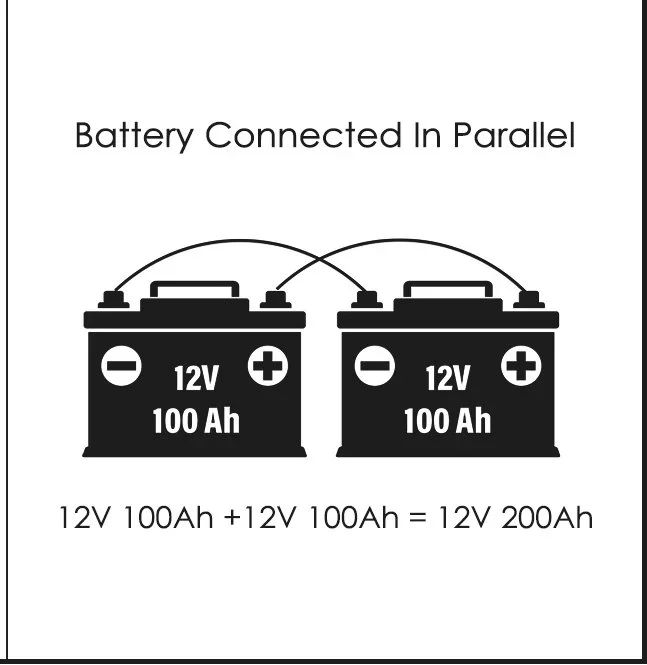Parallel lithium batteries have many advantages, including increased capacity, enhanced power output, and improved overall performance. When multiple batteries are connected in parallel, their individual ampere-hour (Ah) capacities add up, resulting in a higher total capacity. This configuration is commonly used in various applications, from portable electronic devices to electric vehicles and renewable energy systems. However, parallel batteries also face many challenges, especially in balancing the state of charge and ensuring the life of the battery pack. In this article, we will dig into balancing lithium batteries in parallel and explore their significance in achieving optimal battery performance. Read on now!
Can We Connect Lithium Batteries in Parallel?
Lithium batteries can indeed be connected in parallel, and this method is commonly used to achieve higher capacity and extend the runtime of a battery system. By connecting two or more lithium batteries with the same voltage in parallel, the resulting battery pack retains the same nominal voltage but boasts a higher Ah capacity. For example, connecting two 12V 10Ah batteries in parallel method creates a 12V 20Ah battery. This BMS parallel connection is mainly used in applications like electric vehicles, solar panels, household electronics, and boats.
Features of Parallel Lithium Batteries
When lithium batteries are connected in parallel, the voltage remains the same, and the battery capacity increases. This configuration reduces the overall internal resistance of the battery pack, thus extending the power supply time. According to the parallel principle, the current of the main circuit is equal to the sum of the currents of the parallel branches. Therefore, a parallel lithium battery pack with “n” parallel batteries achieves the same charging efficiency as a single battery, with the charging current being the sum of the individual battery currents.
However, it is essential to consider the changes in internal resistance that can occur when multiple batteries are connected in parallel. The total internal resistance of parallel batteries is calculated based on the sum of the products of individual battery internal resistances and the ratio of the total sum to the individual resistance. This means that the internal resistance of the parallel configuration will vary with the number of cells connected in parallel.

How to Connect Lithium Batteries in Parallel Safely?
In order to prevent potential hazards and optimize battery performance, it is necessary to ensure the safe connection of lithium batteries in parallel. A Parallel BMS plays an important role in achieving safe and efficient parallel battery configurations. It continuously monitors the voltage, temperature and charging status of each battery, ensuring that the battery is balanced and protected during the charge and discharge cycle.
A BMS for parallel cells performs several essential functions:
- Cell Balancing: The BMS for batteries in parallel ensures that all batteries in the parallel configuration have similar state-of-charge levels. It can balance the charge across individual cells or strings to prevent overcharging or over-discharging of any particular battery.
- Overcurrent Protection: The BMS monitors the current flowing through the battery pack and disconnects the circuit in case of an excessive current surge to prevent damage and overheating.
- Overvoltage and Undervoltage Protection: The BMS safeguards against overvoltage and under-voltage situations, disconnecting the battery from the load or charging source if the voltage exceeds safe limits.
- Temperature Monitoring: The BMS monitors each battery temperature, prevents the battery from overheating, and ensures that the battery is operating within the specified temperature range.
- Communication and Data Logging: Some advanced Parallel BMS systems offer communication capabilities, allowing users to access real-time data and log battery performance for analysis and optimization.
- Redundancy Management: In applications where parallel strings of batteries are used, the BMS can manage redundancy and maintain system integrity even if one string fails.
By adopting parallel BMS, the safety and performance of parallel lithium battery configurations are significantly improved for a wide range of applications with higher capacity and power requirements.
Parallel Cells vs. Strings in Parallel
When designing a lithium battery pack, engineers have two primary options: connecting individual cells directly in parallel or connecting strings of cells in parallel. Each approach has its advantages and disadvantages, and the choice depends on the specific application needs and design goals.

Parallel Cells:
Connecting individual cells directly in parallel offers several advantages, making it a popular choice in many applications. A significant advantage is that the batteries balance each other, thus improving overall reliability. When cells are directly paralleled, they share the load, so if one cell becomes faulty, others can compensate for it, reducing the impact on the entire battery pack’s performance. Moreover, the BMS’s complexity is lower, as it only needs to monitor the overall parallel branch voltage, reducing cost and complexity.
Parallel Strings:
Some designers choose to connect strings of cells in parallel, believing it offers advantages like increased reliability, flexibility, and redundancy. Parallel strings can be useful when redundancy is needed, allowing for continued operation even if one string fails. However, this approach presents challenges related to battery changes, maintenance, and potential energy dumps between batteries in different charging states.
| Factors | Parallel Cells | Parallel Strings |
|---|---|---|
| Reliability | Cells balance each other, leading to better overall reliability. | Reliability is compromised due to potential issues with cell variance and maintenance. |
| BMS Complexity | Requires monitoring overall parallel branch voltage only, reducing complexity. | Requires monitoring each string individually, leading to higher BMS complexity. |
| Flexibility | Limited flexibility for adding or removing capacity. | Offers flexibility for capacity adjustments through parallel strings. |
| Redundancy | Redundancy is achieved by cells compensating for each other. | Redundancy is provided by multiple parallel strings, but may not enhance overall reliability. |
| Usable Capacity | Higher usable capacity due to balanced cells. | Lower usable capacity due to eddy currents and the need for headroom in parallel strings. |
| Maintenance | Simplified maintenance with individual cell monitoring is unnecessary. | Requires individual monitoring and maintenance of each parallel string. |
| State of Charge Calc. | Easier to calculate SOC with cells directly in parallel. | Difficult to calculate SOC accurately due to different currents in parallel strings. |
Conclusion
Lithium battery parallel balancing requires careful consideration of various factors to ensure safety, reliability, and optimal performance. MOKOEnergy‘s Parallel BMS offers an innovative solution to efficiently manage parallel battery configurations. Understanding the complexities involved will enable the industry to fully harness the potential of parallel battery systems. The choice between parallel cells and parallel strings should be made based on specific application requirements and the trade-offs between simplicity, redundancy, and usable capacity. By following simple setup and maintenance rules, battery systems can optimize life and efficiency. Contact us and try our parallel BMS for your industrial and commercial applications.
CONTINUE READING ABOUT PARALLEL BMS






